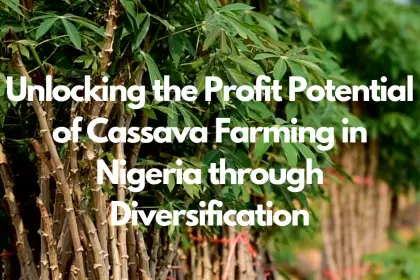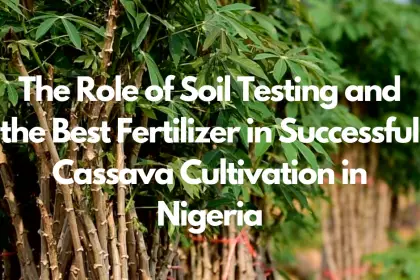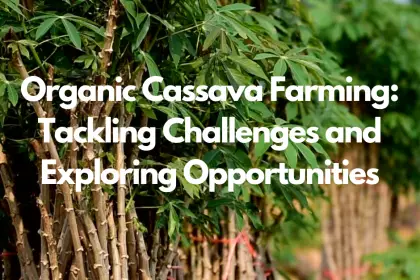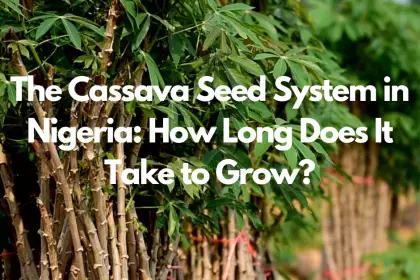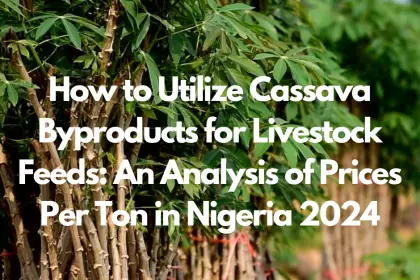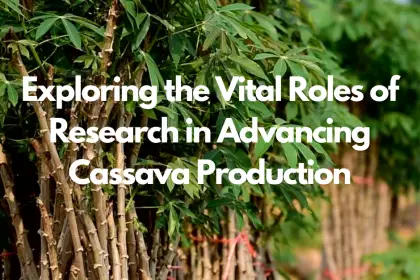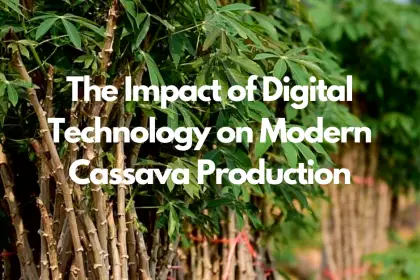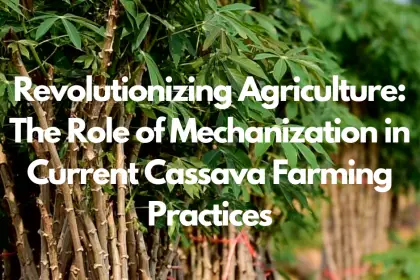Nigeria stands as the world’s largest producer of cassava, achieving an annual output exceeding 34 million tonnes of tuberous roots. This remarkable production figure underscores the pivotal role cassava plays in Nigeria’s agricultural landscape, where it serves not just as a staple food source but also a key element in intercropping systems. The cultivation of cassava has seen a consistent increase over the past two decades, both in the area cultivated and yield per hectare, highlighting the crop’s significance in enhancing food security and supporting rural livelihoods. Furthermore, the cassava benefits extend beyond mere nutrition facts, impacting economic and environmental dimensions of agricultural practices in Nigeria.
This article delves into the practice of cassava intercropping systems in Nigeria, exploring the array of cassava benefits ranging from enhanced soil health, mitigation of iodine deficiency and thyroid disease risks, to improved crop yield and sustainability. The discussion will unfold the economic advantages, environmental benefits, and tackle the challenges faced in optimizing cassava production. Through case studies and success stories, the guide aims to equip farmers and stakeholders with knowledge and strategies to maximize cassava root benefits through effective intercropping practices, ensuring a sustainable and profitable agricultural sector.
Understanding Cassava Intercropping Systems
Cassava intercropping systems, a practice of growing cassava alongside other crops, have been shown to significantly influence the agricultural ecosystem, particularly in terms of soil health and crop yields. This section delves into the mechanisms through which these systems operate and their implications for agriculture in Nigeria.
- Impact on Soil and Microbial Health:
-
- Intercropping cassava changes the bacterial community structure in the soil, especially around the root systems (rhizosphere). This alteration is characterized by an increased presence of beneficial bacteria from the phyla Chloroflexi, Proteobacteria, and Actinobacteria, as well as the genus AD3. These microorganisms are crucial for nutrient cycling and reducing the bioavailability of harmful substances like cadmium (Cd), thus enhancing soil quality and reducing the risk of crop contamination.
- Such systems also lead to a decrease in the relative abundance of pathogenic bacteria and indicators of organic pollution. This not only contributes to healthier soil but also reduces the likelihood of disease transmission to the crops.
- Additionally, cassava intercropping has been observed to boost soil pH and available potassium (K) levels, further contributing to soil health and fertility.
- Yield Optimization and Land Use Efficiency:
-
- Research indicates that the optimal intercrop yields for cassava and sweet potato are achieved when cassava cuttings of 30 cm in length are planted within sweet potato plots. This specific arrangement yields the highest land equivalent ratio (LER) of 2.15, indicating a highly efficient use of land where intercropping cassava with sweet potato saves up to 53.5% of land. This saved land can then be utilized for other agricultural purposes, enhancing overall farm productivity.
- The success story of a farmer from Ikakumo, Akoko Ondo State, who successfully intercropped cassava with carrots, highlights the practical applicability and benefits of these systems. The soil in Ikakumo has been reported to be particularly conducive for both cassava and carrot cultivation, with plans to extend this practice to include onions in the next planting season.
- Ecosystem Services and Crop Performance:
-
- Intercropping cassava with a diverse range of crops, such as maize, legumes, and even trees, can significantly enhance key ecosystem services. These include pest suppression, disease control, soil and water conservation, land productivity, and biodiversity. Such diversity in intercropping systems not only contributes to more resilient agricultural practices but also increases food production per unit of land. For instance, maize and bean-based intercropping systems with cassava have shown remarkable performance.
- The practice also offers microclimate modifications, like reduced light intensity and cooler air temperatures, which are beneficial for crop growth. Moreover, factors such as plant population, crop duration, and resource use efficiency are crucial in determining the success of these intercropping systems, highlighting the need for strategic planning and management.
In summary, cassava intercropping systems present a multifaceted approach to improving agricultural productivity, soil health, and ecosystem services. By carefully selecting companion crops and managing the intercropping arrangements, farmers in Nigeria can harness these benefits to achieve sustainable and profitable farming operations.
Economic Benefits of Cassava Intercropping
Intercropping systems, particularly involving cassava, have demonstrated substantial economic benefits in Nigeria, a country recognized as the world’s largest producer of cassava. These benefits encompass increased crop yields, improved productivity of plant constituents, enhanced economic returns, and notable social benefits. Here, we explore the economic advantages of cassava intercropping, focusing on profitability, labor, and farm size impacts, as well as the role of women and cooperative farming.
- Profitability and Yield Enhancements:
-
- The cassava/cowpea intercropping system emerged as highly profitable, with net margins reaching 127,249.63/ha in Ogun State and 122,325.73/ha in Oyo State. This indicates a significant economic advantage over mono-cropping systems.
- Application of cassava cuttings and the strategic use of herbicides have been shown to significantly increase the profitability for small to medium-scale cassava farmers. For instance, herbicide use alone has markedly improved financial returns in both Ogun and Oyo States.
- A notable increase in profitability was observed with higher maize planting densities and fertilizer application, which not only increased the marketable maize cob yield but also the cassava storage root yield. The average value-to-cost ratio (VCR) of fertilizer use in the FM regime was 3.6, highlighting the economic efficiency of input use in intercropping systems.
- Labor and Farm Size Considerations:
-
- Labor and farm size have been identified as critical factors in enhancing the profitability of large-scale cassava farming operations. In Oyo State, increasing labor use, and in Ogun State, expanding the cultivated acreage, are recommended strategies for boosting cassava production efficiency.
- Organizing small cassava farmers into cooperatives has shown to unlock higher economic potentials, especially in cassava processing and marketing. This collective approach facilitates better access to markets, resources, and information, thereby improving profitability.
- Role of Women and Diversification:
-
- Women contribute approximately 58-67% of the total agricultural labor in cassava production, processing, and marketing, playing a pivotal role in the cassava value chain. Their involvement is crucial for the economic success and sustainability of cassava intercropping systems.
- Diversification strategies, such as converting cassava waste into animal feed, offer additional income streams for cassava farmers. This not only enhances economic returns but also promotes environmental sustainability by reducing waste.
These economic benefits underscore the attractiveness of cassava intercropping as an alternative to traditional mono-cropping systems in Nigeria. By leveraging these advantages, farmers can achieve sustainable and profitable farming operations, contributing positively to poverty alleviation and food security in the region.
Environmental Advantages
Cassava intercropping systems offer a sustainable approach to agriculture that significantly mitigates the negative environmental impacts often associated with farming practices. By integrating cassava with other crops, such as maize, grain legumes, and trees, these systems enhance key ecosystem services crucial for maintaining ecological balance. Here are the environmental advantages of cassava intercropping:
- Ecosystem Services Enhancement:
-
- Pest Suppression and Disease Control: Intercropping cassava reduces the incidence of pests like whitefly and mealybugs, crucial vectors for plant diseases, thereby minimizing the need for chemical pesticides.
- Soil and Water Services: The practice increases soil moisture content and water infiltration rates, crucial for adapting to climate-induced droughts and floods. Furthermore, erosion levels are often halved, preserving soil integrity.
- Land Productivity: Through strategic plant arrangements, such as intercropping 40,000 maize plants per hectare with 12,500 cassava plants and optimizing fertilizer regimes, significant improvements in land productivity are observed, including enhanced grain yield and efficient use of photosynthetically active radiation.
- Soil Health Improvement:
-
- Microbial Community Structure: The relay intercropping system alters the soil’s bacterial community, especially around the cassava’s rhizosphere, reducing pathogenic bacteria and enhancing beneficial microorganisms. This leads to improved soil health and fertility.
- Nutrient Mobilization: Intercropping cassava with peanuts, for instance, increases available nitrogen contents due to a rise in the quantity of rhizospheric microbes, particularly Nitrospirae. Such interspecific interactions in the rhizosphere soil improve the mobilization and uptake of nutrients, contributing to farmland biodiversity.
- Resilience and Environmental Health:
-
- Cassava intercropping systems strike a balance between farm-level productivity and crop resilience while promoting environmental health. The diversity in cropping systems not only bolsters agricultural resilience to pests and diseases but also ensures a steady improvement in food production per unit of land. For example, maize and bean-based systems with cassava perform exceptionally well, underscoring the potential of intercropping in achieving sustainable food security.
By leveraging these environmental advantages, cassava intercropping stands as a testament to the potential of integrated farming practices in fostering a balance between agricultural productivity and ecological stewardship. This approach not only contributes to the sustainability of farming operations but also plays a vital role in the broader context of environmental conservation and climate change adaptation.
Challenges and Solutions in Cassava Intercropping
Despite the numerous benefits of cassava intercropping in Nigeria, several challenges hinder its full potential. Addressing these issues requires a comprehensive understanding and strategic solutions:
Key Challenges:
- Land Acquisition and Cultural Practices:
-
- Difficulty in acquiring enough land for expansion due to entrenched cultural practices.
- Production Constraints:
-
- Pests and diseases (e.g., mosaic disease, cassava bacterial blight).
- Agronomic problems and land degradation.
- Shortage of quality planting materials.
- Economic and Market Access:
-
- Changes in food policy and access to markets.
- Limited processing options and inefficient extension delivery systems.
- Market access, price fluctuations, and challenges in storage and transportation.
- Environmental Factors:
-
- Vulnerability to weather variability and climate change.
Proposed Solutions:
- Research and Development:
-
- Future research to focus on economic and social factors influencing intercropping adoption.
- Development and rapid multiplication of improved cassava varieties.
- Extension of improved agronomic practices and pest and disease control measures.
- Infrastructure and Technology:
-
- Support for cassava processing prototypes and technology for local entrepreneurs.
- Development of labor-saving technology for cassava harvesting.
- Extension and Education:
-
- Strengthening extension-farmer linkage with research for spreading cultivars and practices.
- Strategic Partnerships:
-
- Affiliation with organizations like IITA for access to disease-free seedlings.
- Creating a network of buyers and effective supply chains for better market access.
Implementing Solutions:
- Enhancing Access to Quality Planting Materials:
-
- Rapid dissemination of improved varieties to ensure diversity and availability.
- Building Resilience to Environmental Changes:
-
- Adoption of organic farming practices like mulching to maintain soil health.
- Utilization of non-toxic pesticides for pest control.
- Strengthening Market Linkages:
-
- Establishing pre-cultivation negotiations with buyers to secure competitive prices.
- Improving transport facilities to ensure efficient cassava movement and reduce spoilage.
Addressing these challenges through targeted interventions can significantly enhance the sustainability and profitability of cassava intercropping systems in Nigeria. By focusing on research, infrastructure, education, and strategic partnerships, stakeholders can unlock the full potential of cassava benefits while mitigating the associated risks and obstacles.
Case Studies and Success Stories in Nigeria
In Imo State, Nigeria, Veronica Njoku, Vice President of the Aladinma Umukabia Ogodo Multi-purpose cooperative society, which consists of over 200 women cassava farmers, shared a compelling success story. With the assistance of the PIND Foundation, a Nigerian NGO dedicated to sustainable development, Veronica and her cooperative experienced transformational changes in their cassava farming practices. The foundation introduced a cassava demonstration plot, which served as a practical learning tool for the farmers.
Key interventions and outcomes for Veronica and her cooperative included:
- Introduction of Improved Farming Techniques:
-
- Ridge Making: Learning to make ridges for planting cassava, which significantly improved the growth environment for the cassava, leading to healthier plants and higher yields.
- Use of Improved Varieties and Fertilizers: Adoption of high-yield cassava varieties and appropriate fertilizers, which further boosted cassava production.
- Impact on Yield and Income:
-
- Doubling of Production: Veronica’s yield saw a remarkable increase, from 50 full bags of cassava to 100 full bags, effectively doubling her production.
- Enhanced Family Support and Additional Income: The increased yield allowed Veronica to better support her family’s needs, including her children’s education. Moreover, she was able to generate additional income by selling cassava stems.
- Broader Benefits to the Cooperative:
-
- Skill Development: The intervention not only improved cassava yields but also contributed to building the management skills of the cooperative members.
- Exposure to New Opportunities: The cooperative was introduced to other agricultural opportunities, such as beekeeping, expanding their potential income sources.
The case of Veronica Njoku and the Aladinma Umukabia Ogodo Multi-purpose cooperative society highlights the significant potential of targeted interventions in transforming cassava farming practices. Cassava, being a staple food in Sub-Saharan Africa and particularly crucial in Nigeria, where it provides at least one-third of the calorie intake, plays a vital role in the food security and economic well-being of the population. The success story underscores the importance of adopting improved farming techniques, leveraging cooperative structures, and exploring diversified agricultural practices to maximize cassava benefits in Nigeria.
Conclusion
Throughout this comprehensive exploration of maximizing cassava benefits through intercropping systems in Nigeria, we have traversed various dimensions including the improved agricultural productivity, soil health, and the broader economic and environmental advantages inherent to these practices. The critical role of intercropping in enhancing crop yield, optimizing land use efficiency, and bolstering the ecological sustainability of agricultural methods underscores its pivotal importance in Nigeria’s agricultural ecosystem. By examining the practices, challenges, and successful strategies, this guide aims not only to enlighten but also to encourage the adoption of such beneficial cultivation techniques among farmers and stakeholders.
As we conclude, the significance of embracing and promoting cassava intercropping systems becomes ever more apparent, promising not only to revolutionize cassava production but also to contribute substantially to food security, economic development, and environmental conservation in Nigeria. The implementation of the discussed strategies, coupled with targeted research and supportive policies, holds the key to unlocking the immense potential of cassava intercropping. It urges a collective movement towards sustainable agriculture practices, ensuring a more resilient, productive, and ecologically harmonious future for Nigeria’s agrarian society.
FAQs
What is the most suitable crop to grow alongside cassava?
Cassava is commonly intercropped with maize, where it tends to be the dominant plant, especially when paired with lower-growing species. When cassava is grown with maize or legumes, there is a notable biological benefit, as evidenced by the (modified) Area × Time Equivalency Ratio (ATER) values exceeding one, indicating a more efficient use of space and time compared to growing the crops separately.
What crops can be cultivated concurrently with cassava?
You can grow cassava with a variety of other crops, including yam, maize, and various vegetables. This practice allows for the efficient use of farmland and can lead to enhanced productivity and soil health.
How can cassava yields be improved?
To boost cassava yields, particularly in arid regions, horizontal planting is recommended. Employing the rapid multiplication technique is also advantageous for generating a large supply of cassava stems, which can be used as planting material in future planting seasons. It’s essential to select and plant improved cassava varieties that are healthy and resistant to pests and diseases.
What are the key phases in cassava cultivation?
The process of growing cassava involves several critical steps:
- Choosing an appropriate site for the farmland.
- Preparing the soil for planting.
- Selecting the right cassava variety to plant.
- Gathering the necessary equipment for cultivation.
- Implementing irrigation systems if needed.
- Understanding the climatic conditions suitable for cassava.
- Planting the cassava stems properly.
- Regularly controlling weeds to ensure healthy cassava growth.


